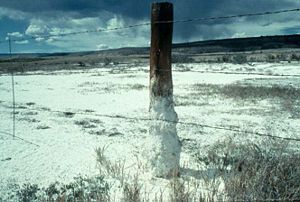
Salination, salinisation, or soil salinity is the salting of the earth or soil in land either through human-induced or natural causes. It often occurs in land that has been used for agricultural purposes or where land has been cleared of native habitat. Excessive irrigation causes the water table to rise and in so doing, dissolved salts are brought to the soil's surface. Climatic change, seawater floods and general erosion over time can also bring about soil salinity and other causes include the salting of roads in winter, disrupting normal drainage patterns (with dams, etc.) and aquaculture. Once soil has been salinated, it is no longer fertile, and once valuable farming land can no longer be used to produce crops or to graze animals.
Extent of problem[edit | edit source]
Some areas of the world are more prone to salination problems than others. Australia is a well-known example of former farming land having to be abandoned due to increased salinity from agricultural practices. However, globally many areas of land are now salt affected, with at least 100 countries identifiably struggling with salination of some of the country's soils.
Salinity in soils reduces crop yield and in many cases, crops cannot be grown. It can damage human buildings and infrastructure through corrosion. Water supplies can be impacted when they become too saline to drink. Eventually, the soil may begin to erode completely as it can no longer hold its structure. In effect, soil salinity presents a very serious threat to food, fibre and fuel production wherever it occurs.
Types of soils affected by salt[edit | edit source]
Two principal soils are salt-affected:
- Saline soils – these contain high levels of sodium chloride (NaCl), sodium sulfate (NaSO4), or neutral salts.
- Sodic, alkaline, or clay soils – while these have lower levels of salts, they have enough alkali salt sodium carbonate to harm the soil. Salt can cause heavy soils to break down through ion exchange processes.
Measuring soil salinity[edit | edit source]
To measure salinity in soil, an electrical current is passed through a sample of the soil. The electrical conductivity (EC) of the soil can be measured in deciSiemens per metre (dS/m). Where the salt content is low, so too will be the dS/m rating and vice versa.
Some crops begin to be affected at a dS/m of levels 2 to 4, while many crops are affected at levels 4 5o 5 dS/m. Any dS/m level above 8 will impact the majority of crops.
Remedies for salinated soils[edit | edit source]
In some cases, the only remedy is to cease agricultural practices or to find new land. There are no current chemical amendments to fix the problem. Some possible solutions might include:
- Growing salt-tolerant crops
- Flood irrigation – an attempt to wash away salts
- Leaching requirement method - applying more water than the plants need to try and remove salts below the root zone
- Improving drainage
- Managed accumulation – trying to move salts away from crops to areas of soil where it's not such an issue
- Resting the area for a long period and planting salt-tolerant trees or plants to try and clean up the soil.
Each remedy method is dependent on the location, the extent of salinity, the available resources and having an expert assess the particular situation.
Sources and Citations[edit | edit source]
- http://www.eolss.net/Sample-Chapters/C10/E5-01A-04-05.pdf – research source (PDF document)
- http://www.ext.colostate.edu/pubs/crops/00503.html – research source